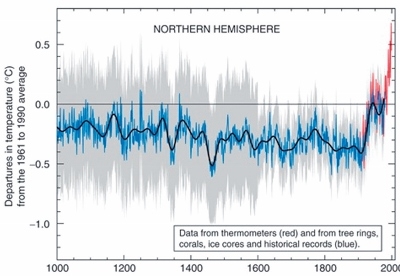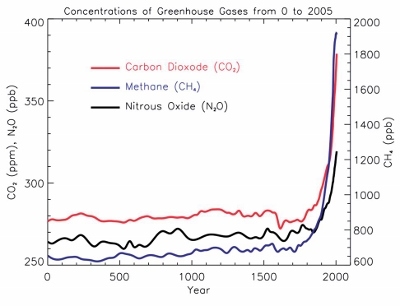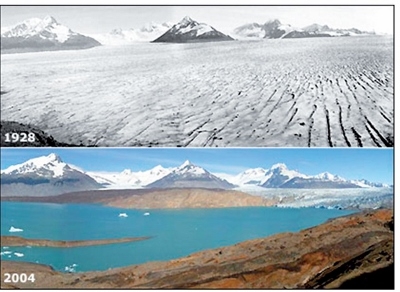Earth’s Got a Fever!
Since we started taking the planet's temperature 120 years ago, measurements show a global mean warming of close to one degree Celcius. There were ups and down in the temperatures, but today the global temperatures are warmer than they were when we were born. One degree may not sound like a lot. However, let's compare that to the fever we get when we are sick. With our mean body temperature 37o C, a one or two degree increase makes us feel rather weak, sick and grouchy. A 3-4o degree increase in our body temperature can kill us. The mean temperature of the Earth is 14o C, and a one degree warming is also starting to make the Earth act strange, with changes in rainfall patterns, heat waves and extreme weather. The problem is that the diagnosis for the Earth is another 3 degree warming before the end of the century.
How sure are we about this "global" warming? How good is the data? Is this warming trend really global? This is difficult to say since most measurements of temperature change are taken where we live, which is biased to land, cities, and the northern hemisphere. However, these factors are often taken into consideration by the climate scientists analyzing the historical temperature trends, and we still see a warming of approximately 1oC in the last 150 years.
If we take a look at the last few decades, where we have greater confidence in the global measurements, we note that every decade has been hotter than the previous one (see figure). The last decade was warmer than the 1990s, which were warmer than the 1980s, which were warmer than the 1970s and so on. It should also be noted that while the globe is warming, there are some areas that even today are cooler than during the 1950–1980 period. It should also be noted that the warming is not uniform around the globe. Some places are warming faster than the global mean, others slower. But the 10 hottest years in the last 150 years all occurred since 2000.
However, what is 150 years of observations relative to the history of the Earth? If we wish to look further back in time, we need to use "proxies" that estimate the past temperatures of the Earth relative to the present. Such proxies generally involve methods that can indicate relative changes in the Earth's temperature in the past, compared with the present. These methods use tree rings, corals, lake and ocean sediments, and ice cores. Using many such proxies we can estimate the Earth's temperature over the last 1000 years (see figure below), and even hundreds of thousands of years. Using such methods, we see that during the last 1000 years the Earth was actually in a cooling trend, with a dramatic warming trend that started around 100 years ago.
For those that do not trust the instrumental record or the proxy record from long term climate indicators, additional evidence of global warming comes from mountain glaciers around the globe. The vast majority of glaciers have been retreating over the last century, with many glaciers showing accelerated melting in recent years. In the photo below we see a large ice sheet in Argentina back in 1928, compared with the same view a few years ago. It is clear that this is a global phenomenon, directly linked to the warming of the air temperatures around the globe. There is plenty of other evidence too, all pointing to a warming world. Observations show the melting of the Greenland ice sheet, decreasing winter snow cover, increased ocean temperatures, decreased sea ice in the Arctic, increased humidity in the atmosphere, and rising sea levels. These all point to the world getting warmer, not colder.
So what happened in the last few hundred years that may explain this shift in global temperatures? One thing that is clear is that the concentration of certain gases, called "greenhouse gases", has increased dramatically in our atmosphere in the last few hundred years (see figure below). These gases act like the windows of a greenhouse, trapping heat in the Earth's atmosphere, warming the Earth's atmosphere. The analogy is not perfect, but good enough for this discussion. In the figure we can see the measured concentrations of carbon dioxide (CO2), methane (CH4) and nitrous oxide (N2O) going back 2000 years, as measured in ice cores in Antarctica. The concentrations of these greenhouse gases were fairly stable in the atmosphere until around 1850, when they all started to increase dramatically, a trend that continues today. The dramatic rise in greenhouse gas concentrations is well correlated with the dramatic rise in global mean temperatures.
What caused this rapid increase? It is very clear that this increase started soon after the industrial revolution, when we started to develop steam engines, electricity, cars, agriculture, medicines, etc. As we developed technologies to allow us to increase our standard of living, health, new professions, farming practices, we started living longer, and the world's population started increasing dramatically. In the last 200 years the world's population has increased from less than 1 billion throughout its history, to more than 7 billion, with no stop in sight. This increasing world population needs energy, food, and land in order to live and prosper. All of these needs contribute to increases in the concentration of these greenhouse gases, since CO2 is emitted by the burning of fossil fuels (gas, coal, petroleum), whether in our power plants, our cars, or industry. CH4 and N2O are generated from landfills, from rice fields, livestock, fertilizers, etc. as we feed our growing populations. It is therefore clear that as the global population increases, so will greenhouse gas concentrations, if nothing is done to limit their emissions.
But how do we know that the increasing temperatures are due to these increasing greenhouse gases? Is it simply a coincidence that they started rising dramatically together? To answer this we need to use computer models that can help us understand the cause and effect of different factors influencing the Earth's climate. These include processes related to the atmosphere (the Sun, clouds, rain formation, dust particles, winds, storm systems, etc.), the oceans (currents, salinity, vertical mixing, sea ice, etc), and the land surface (vegetation, snow and ice, volcanoes, agriculture, etc.). These global climate models are extremely complicated, needing the most powerful of computers to run their simulations. Although there are many different models, all of them agree that the global warming observed since the mid-twentieth century cannot be explained by natural fluctuations of the climate system, and can only be explained if we take into account the anthropogenic increase in greenhouse gases observed in the last century.
So if humanity is really changing the climate of the Earth, what is the forecast for the future? Well, this depends a lot on what we do. What scenario will we follow? Do we carry on as business-as-usual, or try to reduce greenhouse gas emissions? The models predict a future warming of an additional 2-5o C by the year 2100. To put this in perspective, during the last ice age 20,000 years ago, with 2km of ice above New York City, the global temperatures were only about 5o C cooler than today. However, it took the Earth 80,000 years to cool that much, while we are talking about a similar magnitude warming in less than 100 years! Such rapid changes, of this magnitude, have never been witnessed in the history of the Earth.
What would such a warming mean? We don't really know, since it has never happened before. However, once again we can use computer models to try to simulate what may happen, or some possible forecasts. All climate models agree on three outcomes: global temperatures will increase, rainfall patterns will change, and sea level will rise. Furthermore, the models generally agree that we will have an intensification of the water cycle. In other words, where it is dry today it will become drier, while wet areas will become wetter, with some regions likely experiencing increased frequencies of heat waves and droughts, while others will experience increased frequencies of floods. Storms may become more intense, including stronger snow storms in winter.
The impact of future climate change will not result in an apocalyptic "end of the world". Nevertheless, things will become very unpleasant for us, to put it mildly. Our cities and countries are built on infrastructures that are based on our present climate. Whether it is crops, water resources, health, energy use, etc., our societies cannot easily adapt to rapid changes in the climate. Drought in Canada can be devastating even though they have no shortage of water. This is because most of the agriculture relies solely on rainfall every year, which is normally plentiful. If the rains stop, or shift, there is no infrastructure in place to cope with this. Even a one meter rise in global sea level will have major consequences. The majority of the world's population lives along the coastlines of the world. In Bangladesh alone, a one meter sea level rise will result in the evacuation of 17 million people! Even developed countries will have great difficulty adapting to future climate change.
Look what happened in New Orleans after Hurricane Katrina hit. The city and state have still not recovered, and the forecasts predict more Katrinas to come. Unfortunately, the weaker undeveloped countries are a lot more vulnerable to climate change, possibly furthering the gap between rich and poor nations. If malaria and other vector-borne diseases spread due to changes in temperature and rainfall, epidemics and pandemics may become a lot more common. If water resources become very limited, will this result in more conflicts between water-stressed countries? Will climate change and stress on third-world populations result in mass migrations, putting additional stress on the developed world? There are many possible scenarios one can consider. None of them look very good.
So are we doomed, or can something be done to prevent future climate change? The short answer is YES we can tackle this problem and reverse the trends in greenhouse gases, and then global temperatures. However, this can only be done with international global cooperation between countries, since this is truly a global problem.
There are two timescales that need to be addressed. In the long-term, we need to move away from the use of fossil fuels. Energy production using fossil fuels (oil, coal and natural gas) emit CO2 into the atmosphere, and with the increasing need for energy, and a growing population, we cannot solve the problem of climate change without addressing the long term change in energy generation. There are numerous options on the table, although most are not practical today.
However, clean sources of energy such as solar power, wind energy, geothermal, hydroelectric, biofuel, and even nuclear have to be considered and introduced.
Massive investment is needed in renewable energy research and development. Nuclear energy is a dirty word in many countries, especially after the recent Fukushima accident in Japan. However, France produces more than 90% of its electricity from nuclear power plants. There is still the problem of what to do with the nuclear waste, but there are solutions for this as well. But when considering the consequence of climate change versus the risk of a nuclear accident, we may prefer the nuclear option. Fuel cells and hydrogen may be a solution for our cars in the future, reducing our dependence on oil. Such a move would also be wise politically, reducing the world's dependence on the OPEC countries. Such a change in priorities may also have other positive political and strategic consequences for countries like Israel.
While working to solve the long-term problem of fossil fuels, the short-term solution is to try to slow down the increase in greenhouse gases. This could involve increased energy efficiency in all sectors, from more efficient power plants, to more fuel-efficient cars, to more efficient use of electricity in our homes. More efficient farming practices and a reduction in industrial emissions would slow the rate of increase in greenhouse gases, giving us some breathing space to find long-term solutions. This is where the Kyoto Protocol was expected to play a role, with a new international policy being negotiated at the moment. But such policies simply delay the real problem, and are not the real long term solution to the problem.
If all else fails, scientists are now starting to talk about geo-engineering. This involves purposely intervening in the climate system to artificially cool the Earth, or to artificially reduce the concentrations of greenhouse gases in the atmosphere. Such projects include injecting microscopic particles into the upper atmosphere (simulating a volcanic eruption) to reflect some of the Sun's radiation back out to space. Other ideas include brightening clouds so that they too reflect more sunlight back to space. Another idea is to fertilize the oceans with iron to enhance to biological activity that will draw out CO2 from the atmosphere during photosynthesis. All of these ideas may work in theory, but as usual, we may be in for some unexpected surprises when we start to play with Mother Nature. The Earth has a fever and if we do not act soon, she will likely be in intensive care in the near future.
Prof. Colin Price is at the Department of Geophysical, Atmospheric and Planetary Science, Tel Aviv University.












Comments